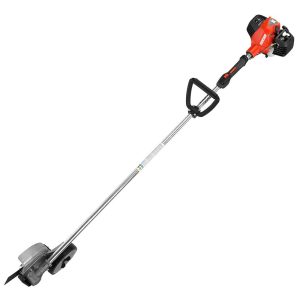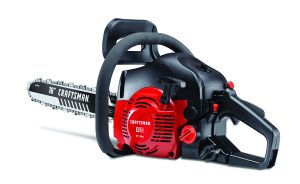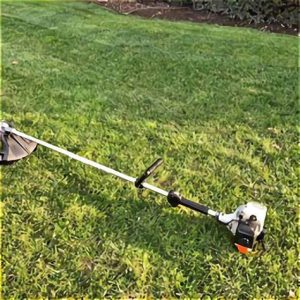Here Are 8 Causes of Honda String Trimmer Sluggishness and Poor Performance.
When your string trimmer runs sluggishly it’s best to begin to look for items that restrict air, fuel, or spark.
A Honda string trimmer runs rough and bogs down due to a dirty carburetor, clogged fuel line, plugged fuel filter, dirty spark plug, plugged fuel tank vent, clogged air filter, plugged spark arrestor screen, or old gas.
Always follow Honda’s safety precautions when operating and working on your trimmer. Remove the spark plug boot, wait for the engine to cool, and wait for all parts to stop moving.

Table of Contents
Your Honda String Trimmer Gets Clogged And Runs Poorly.
1. Damage to a Honda String Trimmer Caused by Stale Gas
If your Honda string trimmer is having trouble starting, you should check the quality of the fuel first. Over time, gas can oxidize and decompose.
A Honda engine may become erratic and sluggish as a result of this.
Ethanol, a plant-based fuel found in most gasoline, is known to attract moisture to the fuel system.
In addition to separating from gas, the ethanol and water mixture will leave behind varnish, which could reduce the amount of fuel reaching the engine.
If you want your engine to run smoothly, you need to use the right fuel and use it up quickly.
When choosing gas for a Honda string trimmer, keep in mind:
- Get new unleaded gas with an octane rating of 87 or higher and no more than 10% ethanol.
- Honda’s 4-cycle engines can only run on unleaded fuel. There’s a dedicated opening for the engine oil.
- Within 30 days, all fuel must be used.
- If you won’t be using the fuel within 30 days, you can extend its shelf life by adding a fuel stabilizer.
- Keep fuel in a cool, dry place away from anything that could catch fire.
To learn more about selecting and storing fuel, check out The fuel mixture for Honda string trimmers consists of gas and oil.
Remove stale gas from the tank. You can keep your string trimmer running smoothly for longer by adding a fuel stabilizer like Sea Foam Motor Treatment or STA-BIL to the fuel.
The new fuel needs to be run through the engine for 5 minutes after it has been mixed with the old fuel.
The Honda string trimmer could start functioning normally again. If not, keep trying the other things on the list until you find the one that does.
2. Honda String Trimmer Fuel Filter Clogged.
Don’t stop at the fuel filter in your search for the source of the fuel restriction. This little cylinder-shaped piece is connected to the fuel line inside the fuel tank.
If the filter isn’t regularly cleaned or replaced, dirt can build up and prevent fuel from reaching the carburetor. The trimmer’s performance will suffer as a result.
The following is how to replace a Honda fuel filter that has become clogged:
- Remove the fuel cap and wipe the area around it to get rid of any dirt.
- The gas tank should be emptied into a new container.
- Put the cutter down on a level surface.
- To remove the fuel filter from the tank, hook the fuel line with a clean, bent wire. You could also try using needle-nose pliers.
- Grab the fuel line firmly and then pull the filter out of the fuel line.
- Replace the old fuel filter with a new one.
- Reinstall the fuel filter inside the tank.
- Refill with clean fuel
- Replace the fuel tank’s cap.
3. Honda String Trimmer Fuel Line Clogged
Check the fuel line for any obstructions or kinks that might be preventing fuel from flowing freely. Fuel that is dirty or old fuel that has left gummy deposits can cause blockages.
If you discover a clog, kink, puncture, or leak in a Honda fuel line, you should replace it with a brand new fuel line.
4. Honda String Trimmer with a Filthy Carburetor
The carburetor controls the ratio of fuel to air during combustion, allowing the Honda to start and run.
If the string trimmer’s fuel-to-air ratio is off, its performance may suffer. Clogging of the carburetor’s passageways and sticking of its many minute parts are both possible.
Because of this, the Honda carburetor may stop delivering adequate fuel to the engine.
You could try cleaning the carburetor to see if that helps. If cleaning doesn’t help, you may need to rebuild (if rebuild kits are available for your carburetor) or replace it.
Damaged carburetors are a common problem caused by the use of stale fuel.
Using fresh gas will reduce wear and tear on the carburetor. For 4-cycle engines, it’s best to use a fuel that doesn’t contain ethanol, such as TruFuel 4-Cycle, to prevent damage to the carburetor.
5. A Honda String Trimmer With A Dirty Spark Plug
A misfiring and sluggish Honda is the result of a spark plug that has been fouled.
Your string trimmer may not be running properly if the spark plug is damaged, the spark plug gap is off, or the spark plug wire is loosened.
The spark plug can be removed with a socket wrench. See how it is doing. In the event that you notice the tip of the spark plug is very dark, the porcelain is cracked, or the electrode is burnt, you should replace the spark plug.
If the spark plug is otherwise functional but dirty, you can either clean it with a wire brush or replace it.
Using a feeler gauge, verify that the spark plug gap satisfies the criteria set forth by the engine manufacturer. Replace or clean the spark plug and install it. Check that the wire connecting the spark plug is properly fastened.
6. Honda String Trimmer with Blocked Fuel Tank Vent
Air must be able to enter the fuel tank through vents as fuel is used. A good deal of fuel won’t reach the carburetor if the tank forms a vacuum because the vent has been blocked.
The car’s engine will sputter and stall as a result of this.
Most Honda string trimmers have a fuel tank vent that is integrated into the fuel cap.
It could be a plugged fuel tank vent if the fuel supply is cut off and there is no obstruction in the fuel line, fuel filter, or carburetor.
A vacuum can be caused by a blocked fuel tank vent and can be detected with a pressure gauge. You can run a test with and without the fuel cap tightened to see if the tank vent is blocked if you don’t have a gauge.
The first step is to remove the fuel cap and let some air into the tank. Turn on the hedge trimmer and let it run. Take care to avoid leaking gas by holding the string trimmer upright.
If your Honda trimmer runs smoothly without stalling or running rough, tighten the fuel cap and see if the problem persists.
If, after tightening the gas cap, your trimmer still acts up and runs roughly, you should replace it.
7. Honda String Trimmer Air Filter Clogged
A Honda string trimmer won’t start up without an air filter. It safeguards the engine by preventing debris from entering the air intake.
If you don’t check, clean, and replace your trimmer’s air filter regularly, it will get clogged with dirt and prevent enough air from reaching the engine.
The engine’s performance will deteriorate without adequate air. Maintaining clean air is crucial to preventing engine overheating and malfunction.
IF THE AIR FILTER IS IN GOOD CONDITION, CLEAN IT AS DESCRIBED BELOW. A new filter should be installed if the old one is severely clogged, damaged, or covered in fuel.
How to Replace the Primary FOAM Air Filter in a Honda String Trimmer:
- Take out the air filter and the cover.
- Foam air filters can be cleaned with warm water and a mild detergent.
- Make sure the water coming out of the filter is clear, and then set it aside to dry in the air.
- After the filter has dried, it should be lubricated with filter oil. Remove any excess oil by squeezing the filter.
- Put the filter back in.
- The air filter cover must be reattached.
Honda uses a wide variety of air filter designs, and the specifics of how to clean yours will be specified in your product’s owner’s manual.
8.The Honda String Trimmer’s Spark Arrestor Was Clogged.
In order to prevent burns or fires from the hot exhaust material, Honda string trimmers have a small metal screen.
Carbon buildup on this tiny screen will impair the performance of the engine.
FIX: Take the wire out of the spark plug. Take off the hood and the exhaust cover. With a metal brush, carefully remove the spark arrestor screen.
Put in place the newly cleaned spark-arresting screen. The engine cover and the exhaust cover must be reattached. Wire the spark plug back in.
A new spark arrestor screen must be installed if the old one is too dirty, damaged, or has a hole in it to be repaired.







